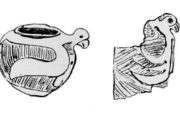The Weeden Island archaeological phase is found on the Gulf Coastal Plain of Georgia and adjacent areas of Florida and Alabama. Named for a site on Tampa Bay, it is a Middle to Late Woodland archaeological culture (A.D. 300-1000 A.D.) defined by the presence of incised, punctated, and red-painted pottery in mounds and midden deposits. Early Weeden Island has a significant presence of Late Swift Creek pottery, while Late Weeden Island has the Complicated Stamped pottery (characterized by a design impressed on the surface of unfired pots with a wooden or clay paddle) replaced by Wakulla Check Stamped sherds. There are only a few known Weeden Island communities, the largest of which is Kolomoki in Early County. Weeden Island burial mounds are best known for the inclusion of elaborate animal effigy pots in large deposits. These mounds represent the burial of a small number of elite members of the society.
Weeden Island peoples had a broad-based economy that included hunting, fishing, gathering, and, probably, gardening. There is growing evidence that they cultivated such native crops as sunflower, gourds, marsh elder, and knotweed, and possibly nonnative plants including corn and beans. The everyday lives of Weeden Island peoples differed little from those of the preceding Swift Creek cultures. However, they developed complex religious and political systems, the most elaborate of which is found at the Kolomoki site, possibly one of the earliest chiefdoms in North America. Weeden Island ceremonial life is a direct development of the earlier Hopewell culture (Middle Woodland) and evolved into the following Mississippian religious and political systems.




